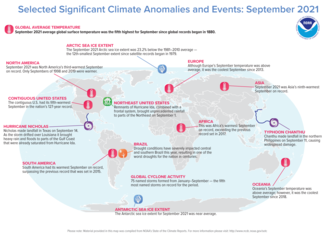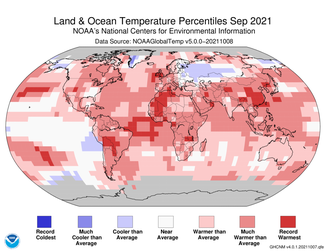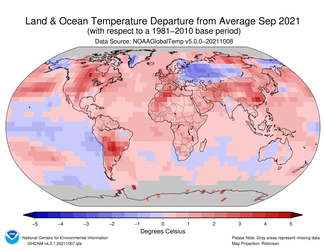Top-five warmest September; record warm in the Southern Hemisphere

The global temperature for September 2021 was the fifth highest for the month of September in the 142-year NOAA record, which dates back to 1880. The year-to-date (January-September) global surface temperature was the sixth highest on record. According to NCEI’s Global Annual Temperature Rankings Outlook, it is virtually certain (>99.0%) that the year 2021 will rank among the 10 warmest years on record.
This monthly summary, developed by scientists at NOAA’s National Centers for Environmental Information, is part of the suite of climate services NOAA provides to government, business, academia and the public to support informed decision-making.
Monthly Global Temperature
The September 2021 global surface temperature was 1.62°F (0.90°C) above the 20th-century average of 59.0°F (15.0°C) -- the fifth-warmest September in the 142-year record. The eight warmest Septembers have occurred since 2014. September 2021 also marked the 45th consecutive September and the 441st consecutive month with temperatures, at least nominally, above the 20th-century average.
Much-warmer-than-average temperatures were observed across parts of North, Central, and South America, Africa, western Europe and southern Asia, as well as across parts of the Atlantic, Indian and Pacific oceans. Temperatures were cooler than average across parts of Alaska, Greenland, western and eastern parts of Russia and central and southern Pacific Ocean.
The Southern Hemisphere’s September 2021 surface temperature departure of +1.26°F (+0.70°C) was the warmest September in the 142-year record. Meanwhile, the Northern Hemisphere had its fifth-warmest September on record.
Regionally, South America and Africa had their warmest September on record, surpassing the now-second warmest September set in 2015 and 2017, respectively. North America had its third-warmest September on record, while Asia had its ninth-warmest on record. Although Europe and Oceania had an above-average September temperature, it was their coolest September since 2013 and 2018, respectively.
Sea Ice
The September 2021 Arctic sea ice extent was the 12th-lowest September extent in the 43-year record at 1.90 million square miles or 575,000 square miles below the 1981-2010 average. According to an analysis by the National Snow and Ice Data Center (NSIDC) using data from NOAA and NASA, the Arctic sea ice extent reached its annual minimum extent on September 16, 2021, marking the end of the summer melt season and the beginning of the winter growth season. The annual minimum extent of 1.82 million square miles was the largest annual minimum extent since 2014; however, it was the 12th-smallest annual minimum extent since records began in 1979.
The Antarctic sea ice extent for September 2021 was 7.12 million square miles, which is close to average. As the Arctic sea ice extent reached its annual minimum extent, the Antarctic reached its annual maximum extent on September 1 at 7.24 million square miles, marking the end of its growth season and the beginning of its melt season.
Global Tropical Cyclones
The global tropical cyclone count from January-September 2021 was 75 named storms -- the fifth-highest number of named storms on record for January-September. The Atlantic basin had above-average hurricane activity during September 2021 with 10 named storms (including Ida), tying 2020 and 2010 for the highest number of named storms in September. The eastern North Pacific basin had one named storm, tying with 2010 and 2011 for the fewest named storms in September since 1981. The West Pacific basin had four named storms, two of them reaching Category 5 (Chanthu and Mindulle).
For a more complete summary of climate conditions and events, see our September 2021 Global Climate Report.



